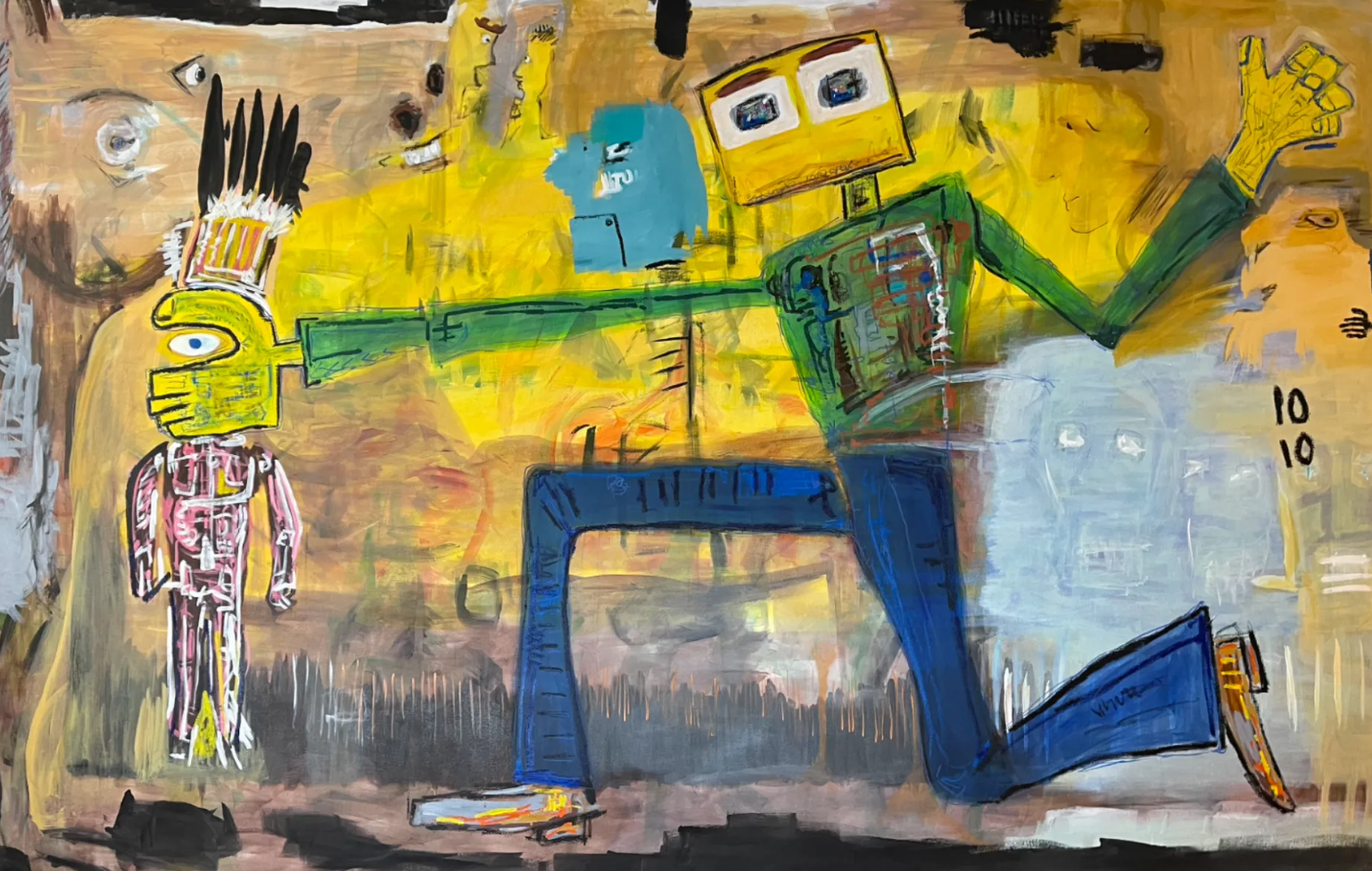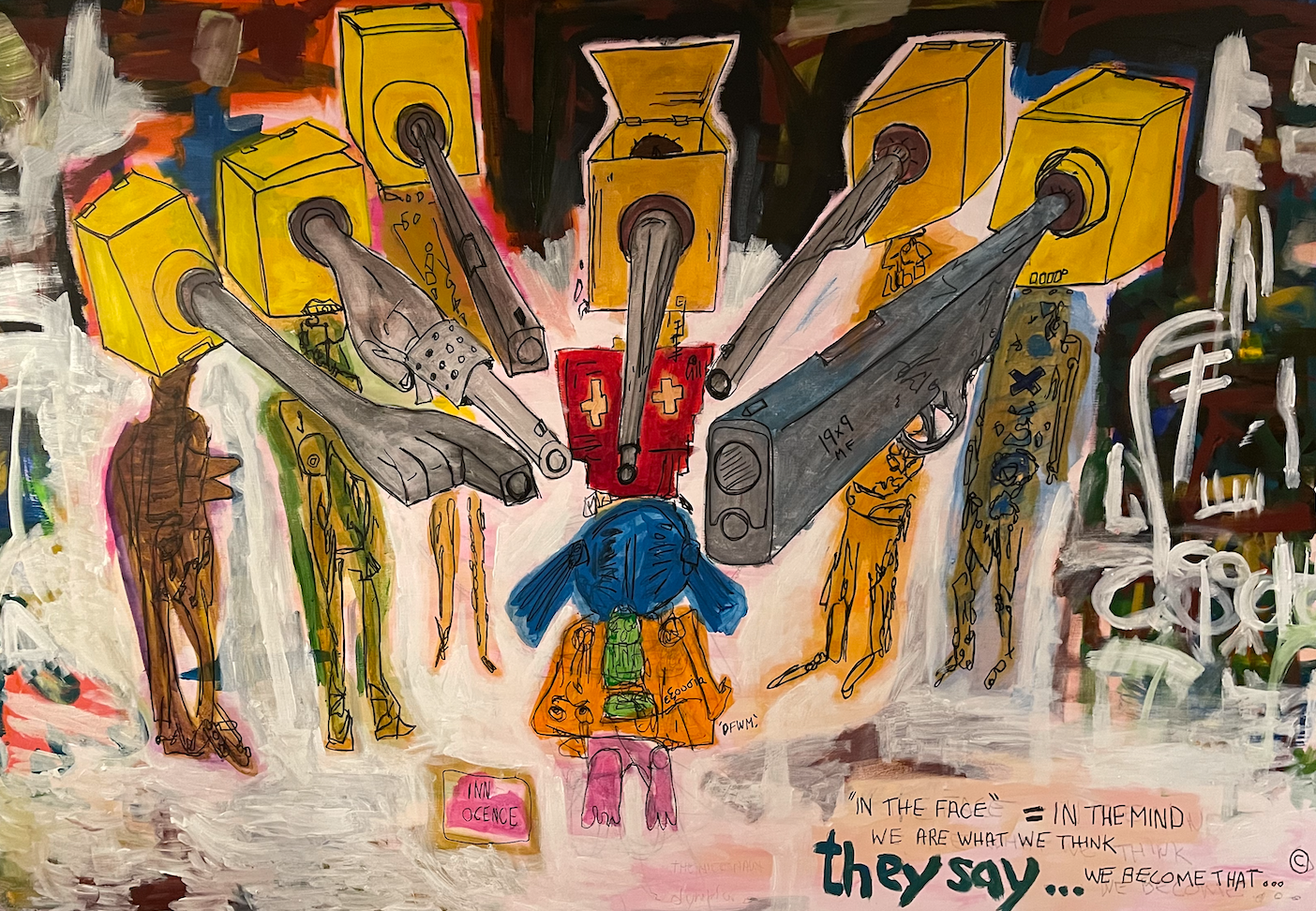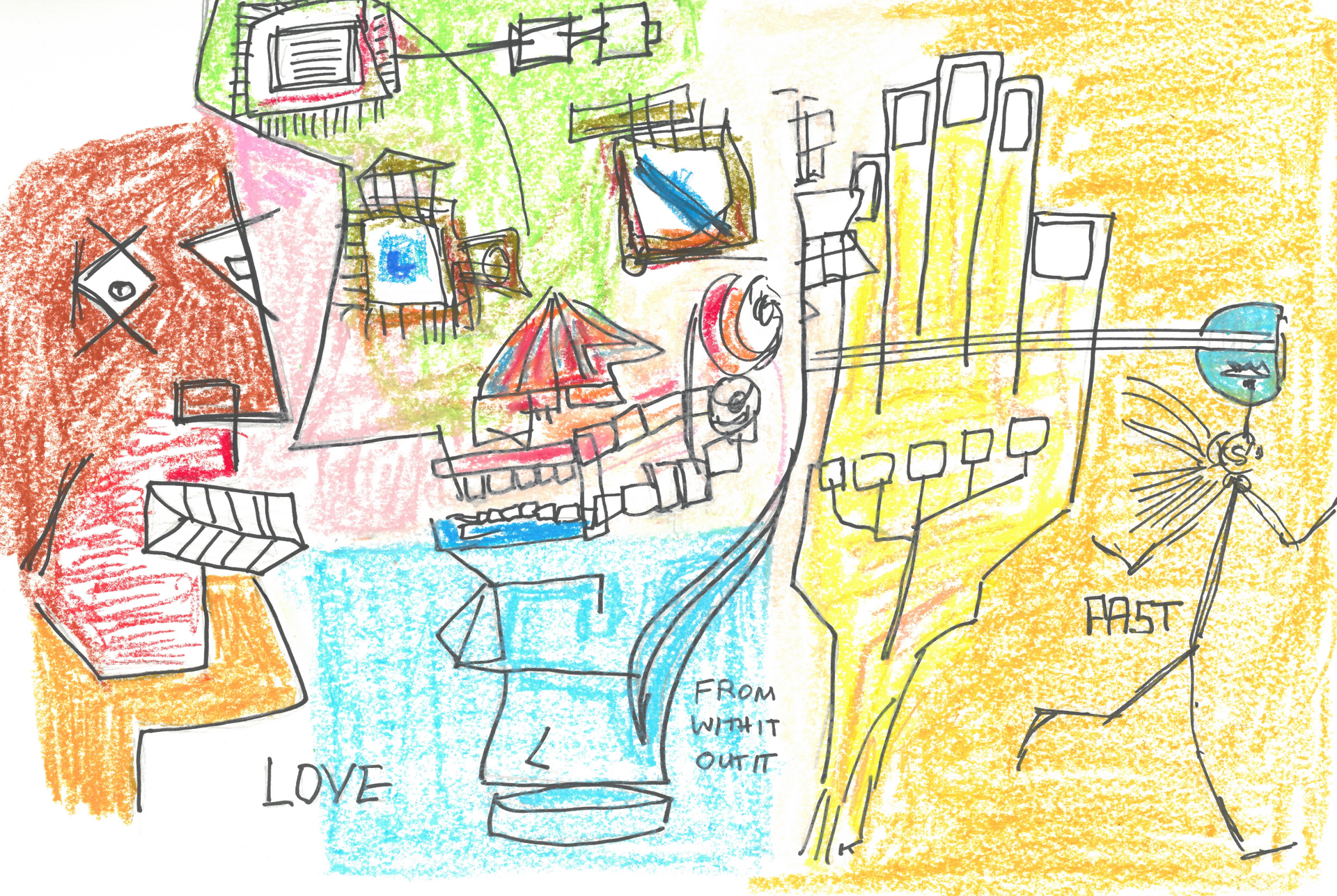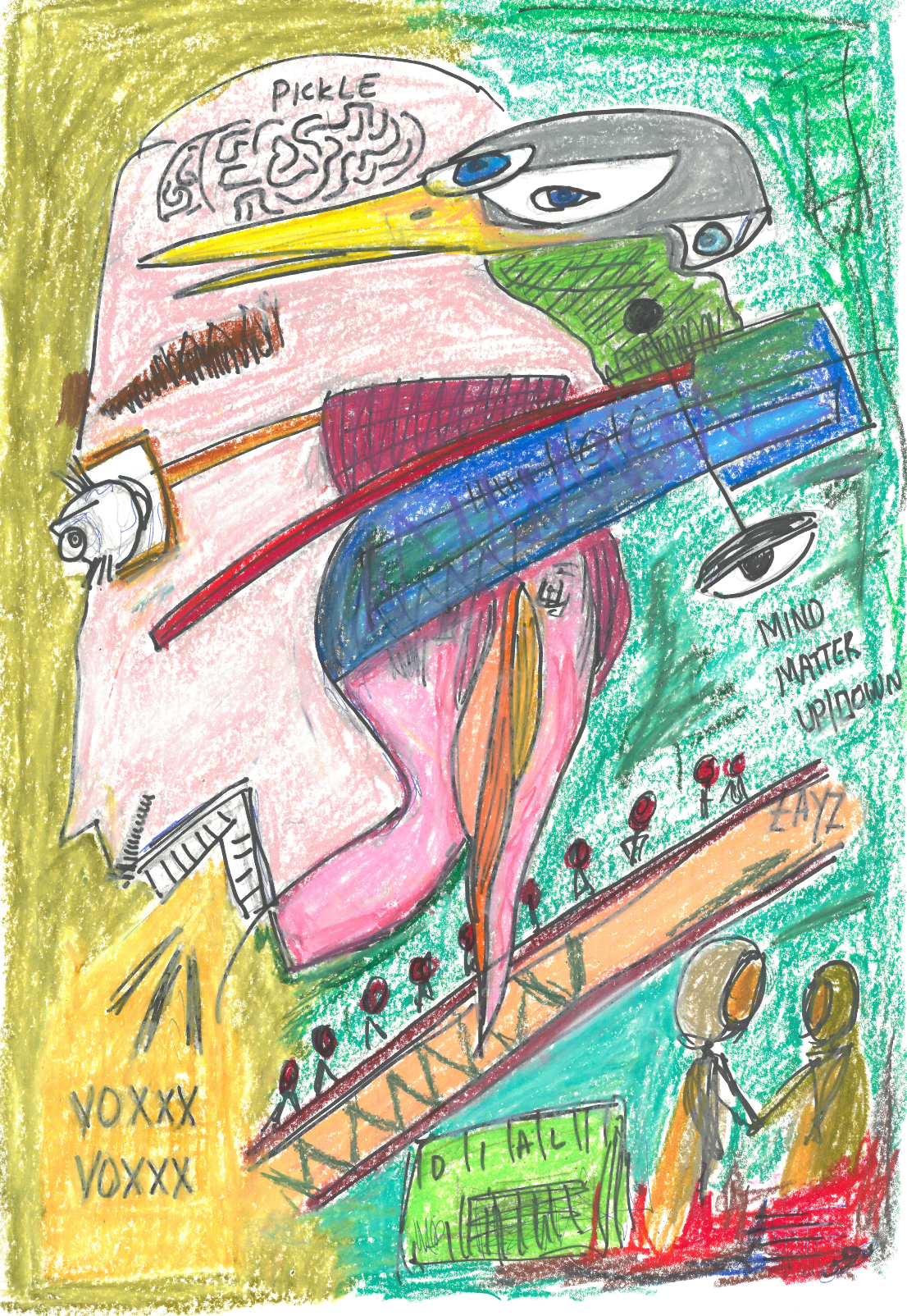UNITY IN VARIETY XIII
Canvas
#024 G.B.America / Space Cowboy, 2020
Acrylic and oilstick on canvas
180 x 280 cm / 71 x 110 inches
G.B. America – Space Cowboy
He reached out.
Not as an offering,
not in peace.
But in the posture of arrival.
They moved away.
Not in fear, but in knowledge.
This isn’t a story of beginnings.
It’s a painting of what was already known,
and what was taken anyway.
The myths came later.
The distance remains.
#041 They Say, 2022
Acrylic and oilstick on canvas
130 x 190 cm / 51.2 x 74.8 inches
They Say...
She was just a girl with a backpack—small, quiet, watching. The world around her was loud, full of opinions—commands dressed as facts, slogans passed off as truths. Every day, she walked through a storm of noise: adults with microphones, strangers with certainty, leaders with agendas. They circled her like giants—square-headed, sharp-edged, armed with ideas that struck like bullets. Some called it wisdom, others called it fear. They told her what was right, what was real, what was worth dreaming. Obedience was expected, rebellion discouraged.
And yet, beneath that quietness, something else stirred. She wasn’t empty. She had a voice of her own—still forming, but there. A mind that could weigh, question, and choose. They shouted, She listened. They insisted, She considered. Their words pushed, but her will stood firm. The world had its script, but she held the pen.
Proverb: They told her what to be—she rewrote the script.
REWIND NA
Crispin Sturrock's piece REWIND NA is a profound commentary on the overlooked plight of the homeless, created to raise awareness and funds for homelessness charity efforts.
The title, "NA" meaning "not applicable," symbolises the way society often treats the most vulnerable—as if their struggles are irrelevant or unseen in the pursuit of progress and wealth.
This painting portrays a stranded family, highlighting the emotional and physical isolation experienced by those left behind in a world obsessed with materialism and self-interest.
The work’s use of yellow and green hues against a blurred backdrop of towering skyscrapers creates a stark contrast between the cold indifference of the corporate world and the fragile hope embodied by the small girl at the centre. Holding a white balloon, she acts as a beacon, signalling distress—a call for help that is often ignored.
The looming buildings overshadow the family, symbolising how societal structures can block out the light of hope and compassion, leaving those in need cold and abandoned.
Through REWIND NA, Sturrock makes an urgent plea to reconsider how we engage with those less fortunate, reminding us that while society’s "hands" may often take from the vulnerable, there is a profound need for love, care, and human connection to restore hope and dignity to those who are suffering.
The work’s donation to charity further exemplifies the artist's commitment to social justice, using art not only as an aesthetic medium but as a tool for real-world impact.
#057 Reunification
Brandenburg Gate Quadriga
Forged in peace, seized by empires, repurposed by ideologies —
the horses return once more. This is the shadow and triumph of Reunification.
REUNIFICATION
This fourth work in the Quadriga Collection titled Reunification — a direct tribute to the monumental sculpture atop Berlin’s Brandenburg Gate, and to the city’s long journey from fragmentation to wholeness.
The Berlin Quadriga, sculpted in 1793 by Johann Gottfried Schadow, was originally a celebration of peace — the goddess Eirene guiding four horses through a triumphal gate. But like the horses of St Mark’s in Venice, this quadriga became a prize of conquest: seized by Napoleon, returned by Prussia, co-opted by the Nazis, and ultimately presided over by the Soviets during Berlin’s partition. These four horses have witnessed empires rise and fall — they are, in essence, the spoils of war and symbols of political theatre.
Reunification is an abstract interpretation of this historic burden. The canvas is scratched with shadows and sigils, flashes of teeth and movement — gestures of command, chaos, and control. An iron-grey palette evokes the cold materiality of the sculpture, while pale marks hint at history’s attempts to whitewash or reclaim it. Ghosts of past ideologies flicker behind the figures. The quadriga becomes a battlefield of memory.
But within the chaos, there is healing. The title reclaims the sculpture’s original spirit — not just as a prize of war, but as a monument to the possibility of unity. Reunification is a visual invocation: that even when torn apart, something greater can be reassembled.
#021 Peace Descending
Quadriga of Wellington Arch
A charge held mid-breath, where conquest gives way to calm.
PEACE DESCENDING
In Peace Descending, Sturrock turns his gaze to the soaring bronze quadriga atop London’s Wellington Arch—a monument not of war, but of its uneasy aftermath. Set against a visceral red that seethes like the final heartbeat of battle, the four horses emerge in stark relief, their lines urgent, animated, almost aflame. Yet at their centre rides not a general nor a king, but a woman: the Winged Figure of Peace, lowering her arms as if to still the storm.
This work is tension incarnate.
The quadriga atop Wellington Arch was sculpted by Adrian Jones and installed in 1912, commissioned decades after the arch itself was built to commemorate the Duke of Wellington’s victories. Ironically, the arch was originally crowned by a vast statue of the Duke himself—unpopular, oversized, and eventually removed. In its place came this newer vision: a celebration not of a man, but of an idea. Peace—not passive or gentle, but triumphant—driving a war chariot once used to glorify empire.
Sturrock seizes this contradiction and runs with it.
The red is not a background—it’s a battlefield. There are ghost motifs lurking in the paint: outlines of conflict, empire, resistance, and memory. The horses are drawn in frantic momentum, their mouths open in defiance or exhaustion. Peace rides with them, but not comfortably. Her presence is ceremonial, precarious, as if only barely holding back the forces beneath her.
There is no neat resolution here. Just as Adrian Jones struggled for years to find funding and approval for his sculpture—just as the arch itself was moved, reimagined, reframed—Peace Descending reflects the dissonance of monuments and memory. Who gets remembered? Who gets replaced? And what do we ask of symbols once the noise has faded?
Sturrock’s rendering of the Wellington Arch quadriga is deliberately unfinished in feeling. The strokes are rushed, the figures wild. This is not peace settled—it is peace attempted. And yet there is dignity here, too. The composition holds, the forms are composed even in their chaos. It is a meditation on restraint. On what it takes to dismount the machinery of war and steer it toward something quieter.
In Peace Descending, we are reminded that peace is never static—it is pulled, steered, and sometimes merely held aloft by will. This is not a painting about stillness. It is a portrait of peace in motion, descending with weight and purpose into a world still struggling to make room for it.
UNITY IN VARIETY XIII
Sculpture
#S003 BAS FONDS - BLUE HAND COLLECTION, 2018
Ceramic with glaze
L50 x W40 x H35 cm / L19 x W16 x H15 inches
BAS FONDS — The Blue Hand (2018)
Bas Fonds The Blue Hand stands as a luminous symbol of the human interior: powerful, vulnerable, and endlessly complex. This large ceramic hand, glazed in a deep shifting blue, rises from the ground like a fragment of a larger being severed yet intensely alive. Within its open wrist lies a maze, an intricate architecture that echoes the hidden turns of thought, memory and emotional experience. As viewers move around the piece, the glaze seems to breathe and change, reminding us that identity is never fixed but constantly in motion. Combining sculptural strength with psychological depth, Bas Fonds invites contemplation of what lies beneath the surface the unseen mechanisms of our lives, our choices, and the private labyrinths that shape who we become.
UNITY IN VARIETY XIII
Paper
#D20-009 - 80.15.05 2020
Oil crayon on paper
42 x 29.7 cm / 16.5 x 11.7 inches
80.15.05
80.15.05 revisits the tension between memory and modernity. The title suggests a timestamp a moment preserved while the imagery hints at the fragile architecture of recollection. Thin lines, partial forms and drifting fragments create a landscape where past and present overlap. The work reflects how personal history can blur, distort or reassemble itself as life evolves. In an age of digital archives and automated nostalgia, 80.15.05 asks what remains authentically ours. Is memory shaped by experience, or by the stories we later tell ourselves? Through sparse composition and emotional restraint, the piece becomes an invitation to reflect on how moments survive not as perfect recordings, but as living echoes shaped by who we have become since.
#D20-018 - Quadriga 2020
Ink on paper
42 x 29.7 cm / 16.5 x 11.7 inches
Quadriga
This work reflects on the long and turbulent journey of the Quadriga horses taken, transported, displayed and reclaimed across empires as a symbol of humanity’s long history of claiming beauty as evidence of power. The original sketch becomes a quiet echo of their monumental story: from ancient Greece to Constantinople, to Venice, then Paris, and finally home again. Rather than illustrating triumph, the piece highlights the uncomfortable truth that the “spoils of war” are never truly possessed, only borrowed from time. Through stark lines and noble faces, the drawing stands as a reminder that art often outlasts the empires that attempt to own it, and that cultural grandeur is frequently built upon cycles of taking, losing and returning.
#D20-019 - Turf 2020
Oil crayon on paper
42 x 29.7 cm / 16.5 x 11.7 inches
Turf
Turf captures the fragile interplay between gravity, fear and perspective. A bright, inverted figure floats between falling and rising, suspended in a moment of internal imbalance. The arrow points downward, urging us to accept gravity’s pull, yet the colours suggest resilience and play. The work explores the psychological experience of “falling” how the mind can distort danger, tilt reality and magnify fear even when we remain firmly on solid ground. Rather than despair, the piece offers reassurance: that imbalance is a moment, not a destiny, and that grounding can come from joy as much as from earth itself. Turf is a reminder that the heaviest force we fight is often not physics, but thought.
#D20-020 - Unity 2020
Oil crayon on paper
42 x 29.7 cm / 16.5 x 11.7 inches
UNITY
UNITY transforms humour into cosmic philosophy. What first appears as a quirky scene a colourful figure guiding a numbered creature reveals itself as a meditation on cycles, consumption and universal rhythm. The dog-machine hybrid represents the looping processes that define existence: input, transformation, release, renewal. The handwritten note, “Most follow in a circle…”, underscores how humans mimic these loops, often mistaking repetition for progress. Vibrant, playful and unsettling, UNITY reflects the deeper structure of the universe from biology to galaxies where everything moves in patterns that feed themselves. The work invites viewers to see connection not as harmony, but as interdependence: the wild, humorous, sometimes absurd unity that binds all life into motion.
#D20-014 - Love 2020
Oil crayon on paper
42 x 29.7 cm / 16.5 x 11.7 inches
LOVE
In LOVE, tenderness meets distortion, revealing how modern affection has been reshaped by screens, speed, and the pressures of digital life. The composition fractures into homes, circuitry, faces and signals a landscape where connection is both sought and strained. The running figure labelled “FAST” symbolises a culture rushing through intimacy, while the central forms evoke both heart and machine. This is not a critique of love’s disappearance but a meditation on its transformation. LOVE reflects on how something once built through patience, presence, and vulnerability now risks becoming compressed, convenient, and emotionally thin. Through vibrant colour and vulnerable line, the work asks a simple question: in an age of instant connection, what does it truly mean to feel?
#D20-004 - VOXXX 2020
Oil crayon on paper
42 x 29.7 cm / 16.5 x 11.7 inches
VOXXX
VOXXX explores the strange new landscape of human communication in a digital age overflowing with noise. The work fuses instinct, machinery and surreal anatomy to ask what happens to our inner voice when every channel is crowded. The figure’s fractured head, the maze-like “pickle brain,” and the marching crowd below hint at the tension between individuality and the algorithmic chorus. With humour and unease, VOXXX reflects a world where thought risks becoming lost in transmission and where clarity is drowned by endless content. It invites viewers to pause in the chaos, to reclaim the quiet space within, and to consider what it means to still think and be heard in a world permanently switched on.
#D20-009 - Primer 2020
Oil crayon on paper
42 x 29.7 cm / 16.5 x 11.7 inches
PRIMER
PRIMER examines the choreography of modern life the motions we inherit before we ever question their meaning. Rendered in raw, immediate lines, the figures appear half-human, half-mechanical, guided by invisible instructions. The repeated forms, blocked mouths, and the solitary word “BLINK” suggest a world where routine masquerades as purpose and people drift through prescribed behaviours. The sketch captures the trance of contemporary existence: efficient, patterned, and quietly disconnected. Yet within the haze, a spark remains the possibility of waking, of recognising ourselves beyond function. PRIMER confronts the viewer with the paradox of a world that teaches obedience before understanding, urging us to see that the first act of freedom is noticing we’re in the loop at all.























